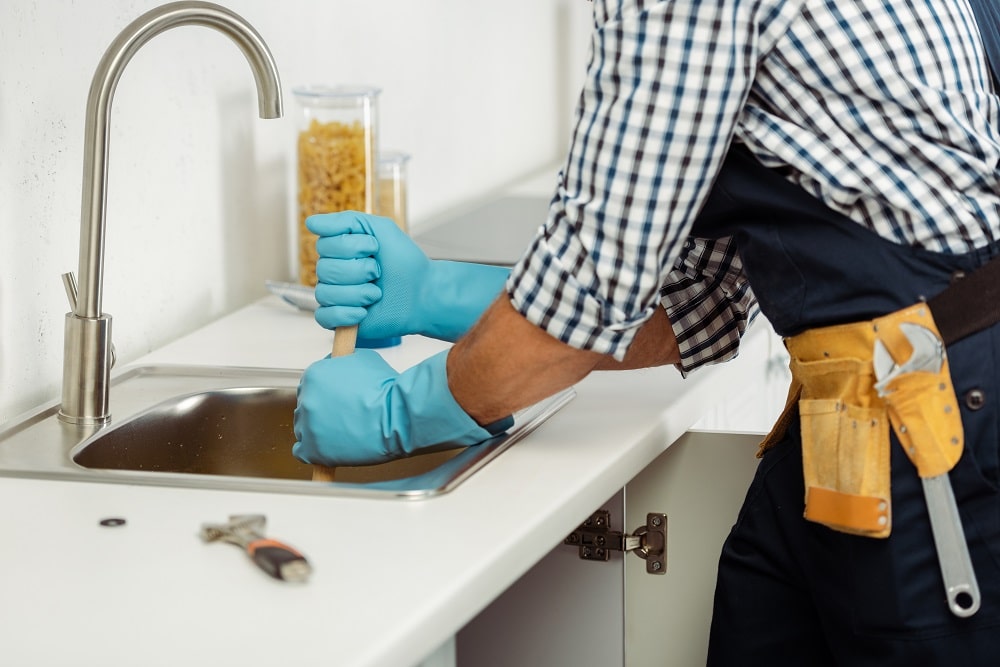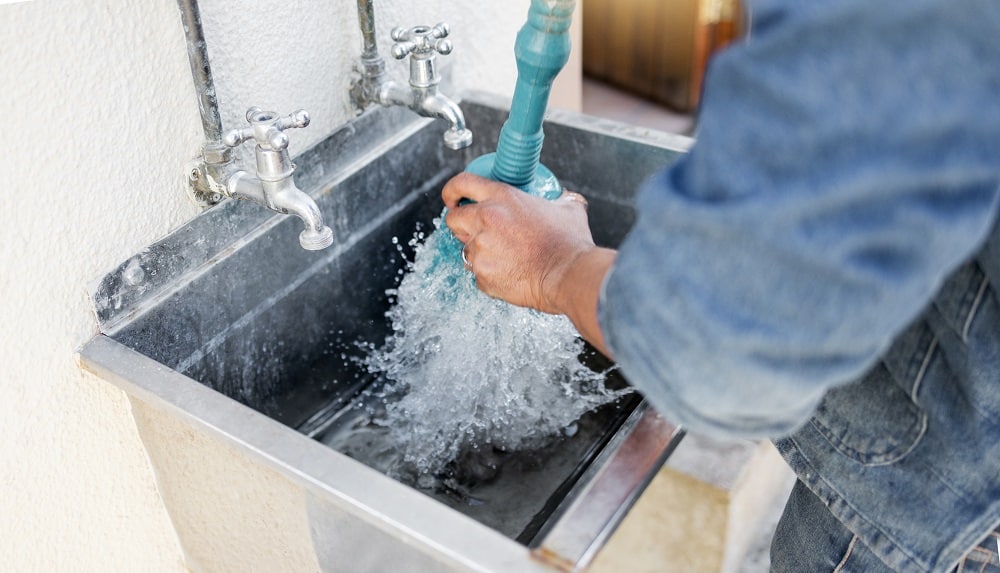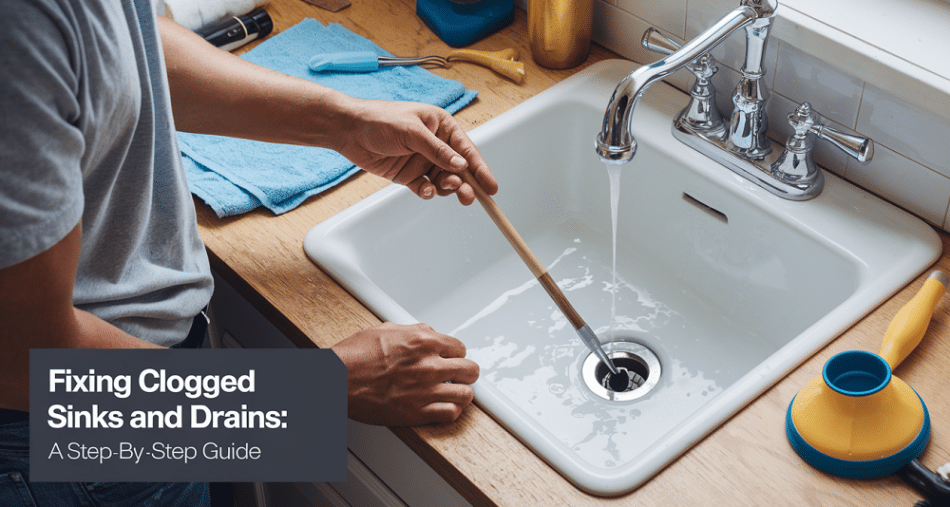Fixing Clogged Sinks and Drains: A Step-by-Step Guide
-
tomsplumbing
-
0 Comment
Table of Contents
- Key Takeaways
- Why Sinks and Drains Get Clogged
- What You’ll Need to Get Started
- Step-by-Step: Fixing Clogged Sinks and Drains
- Figure Out What You’re Dealing With
- Know When to Call a Pro
- How to Avoid Future Sink and Drain Clogs
- Still Clogged? Let an Expert Clear It Right
Clogged sinks are one of the most common and annoying, plumbing problems homeowners face. Grease, hair, soap, and food scraps are usually the culprits. One day your sink drains just fine. The next? You’re standing in a pool of murky water that won’t budge.
Letting clogs sit too long can lead to water damage, pipe strain, and bad smells. The good news is, many blockages can be cleared right at home with the right tools, a little know-how, and some patience.
If you’re dealing with a clogged sink and don’t want to make it worse, contact us at Tom’s Plumbing and Drain Service, LLC. We’ll take care of it quickly and safely, so you don’t have to guess or stress.
Key Takeaways
- Clogs often form from grease, hair, food, and soap buildup in kitchen or bathroom drains.
- Simple tools like plungers, drain snakes, and baking soda can fix most minor clogs without calling a plumber.
- Avoid using chemical cleaners unless necessary, they can damage pipes if misused.
- Regular drain cleaning, smart disposal habits, and using drain screens help prevent future clogs.
- If clogs return often or affect multiple drains, professional help is the safest choice.
Why Sinks and Drains Get Clogged
In kitchens, grease, food bits, and dish soap buildup are common problems. In bathrooms, hair, toothpaste, and soap scum cause blockages. Over time, these materials cling to pipe walls and restrict water flow.

You might notice gurgling sounds, slow drainage, or unpleasant odors. These are signs that a clog is forming or already there. Acting early can keep things from getting worse.
What You’ll Need to Get Started
Before starting, gather a few basic tools and supplies that make the job easier:
- Plunger: Great for minor blockages in kitchen and bathroom sinks.
- Drain Snake: Useful for hair or deeper clogs beyond reach of a plunger.
- Bucket & Pipe Wrench: Needed to remove and clean the P-trap under the sink.
- Shop Vacuum: Helpful for pulling out standing water or loose buildup.
- Spare Parts: Items like rubber gaskets or washers may be needed when reassembling.
Wear rubber gloves and, if using any cleaning solutions, eye protection as well.
Step-by-Step: Fixing Clogged Sinks and Drains
Most clogs can be handled without calling a plumber, if you know the right steps. Here’s how to clear your sink and drain the smart way.
1. Figure Out What You’re Dealing With
Start by checking how the water is behaving. Is it draining slowly or not moving at all? If more than one fixture is draining poorly, there may be a blockage deeper in the system.
If your sink has a garbage disposal, turn it off and check for trapped food. Often, clearing the disposal solves the entire problem.
2. Clean the Sink Strainer
Remove the strainer from the drain and clean off any visible buildup. Use a sponge or brush to get rid of trapped food or hair. A quick rinse and reset can sometimes restore proper flow on its own.
3. Use a Plunger
Choose a plunger that fits well over the sink opening. Cover the overflow hole with a damp cloth to seal air flow. Plunge forcefully in short bursts for 15 to 30 seconds. This creates pressure that may dislodge the clog.
4. Use a Drain Snake
Insert the drain snake into the opening and feed it slowly. When you feel resistance, rotate the handle gently to latch onto the blockage. Pull the snake out and clean it off. This works well on hair clogs or compacted food and grease.
5. Try Baking Soda and Vinegar
Pour half a cup of baking soda into the drain, followed by half a cup of vinegar. Let the mixture fizz for 15 to 30 minutes. Then flush the drain with hot tap water (avoid boiling water if you have plastic pipes). This method works best for minor grease or soap buildup.
6. Use Chemical Cleaners (If Needed)
If the clog remains, a chemical drain cleaner may help, but use it with care. These products are strong and can damage older pipes if misused. Never mix them with other cleaning solutions, and make sure to read and follow the label instructions exactly.
Always ventilate the area well and keep pets and kids out of the space while working with chemicals.
7. Clean the P-Trap
Place a bucket under the sink to catch water. Use a pipe wrench to loosen and remove the P-trap (the U-shaped pipe below the drain). Clean out debris, rinse the pipe, and reattach it. This area is a common spot for food particles and buildup.
8. Rinse With Hot Water
After removing the clog, flush the drain with hot water. This helps wash away any loose residue and gives you a sense of how well water is flowing again. If your pipes are plastic, use only hot tap water, not boiling.
9. Test the Flow
Run water from the faucet and watch how quickly it drains. If the water flows without backing up or gurgling, the clog is likely gone. If it’s still slow, you may need to repeat a few steps or explore further.
Know When to Call a Pro
If the drain continues to act up or if more than one area in your home is clogged, it could be a larger issue in your sewer line. Frequent backups, foul odors, or bubbling water are red flags.
For trusted sinks and drain services in New Orleans, reach out to a licensed plumber who knows how to handle old plumbing, weather-related damage, and recurring clogs.
How to Avoid Future Sink and Drain Clogs
Keeping your drains clear doesn’t have to be difficult. Small changes in routine can help prevent the same problem from coming back.
Clean Your Drains Regularly
Flush your sinks weekly with hot water and dish soap to break up minor buildup. Once a month, use baking soda followed by hot water to freshen up the drain.
Run ice cubes through the garbage disposal to clean the blades and remove odors. A yearly inspection by a plumber can help catch small problems before they become expensive repairs.
Watch What Goes Into the Drain
Let grease cool, then throw it away instead of pouring it down the sink. Wipe dishes before rinsing and avoid flushing large amounts of food.
Don’t overload the garbage disposal, and avoid putting in fibrous or starchy foods. Clean out hair catchers in bathroom sinks regularly.
Never flush wipes, even the “flushable” kind.
Use Drain Screens

Keep Up With Seasonal Maintenance
In cold weather, protect exposed pipes from freezing with insulation. During fall, clear out leaves from outdoor drains to avoid blockages and backups. Adjust your habits with the seasons to protect your plumbing year-round.
Still Clogged? Let an Expert Clear It Right
Still dealing with a slow or clogged drain? Don’t let it sit and get worse. Whether you need a quick fix or full professional support, Tom’s Plumbing and Drain Service, LLC is here to help.
Our team has the tools, experience, and local knowledge to handle any blockage, big or small. Call us today, and we’ll get your plumbing back on track.



